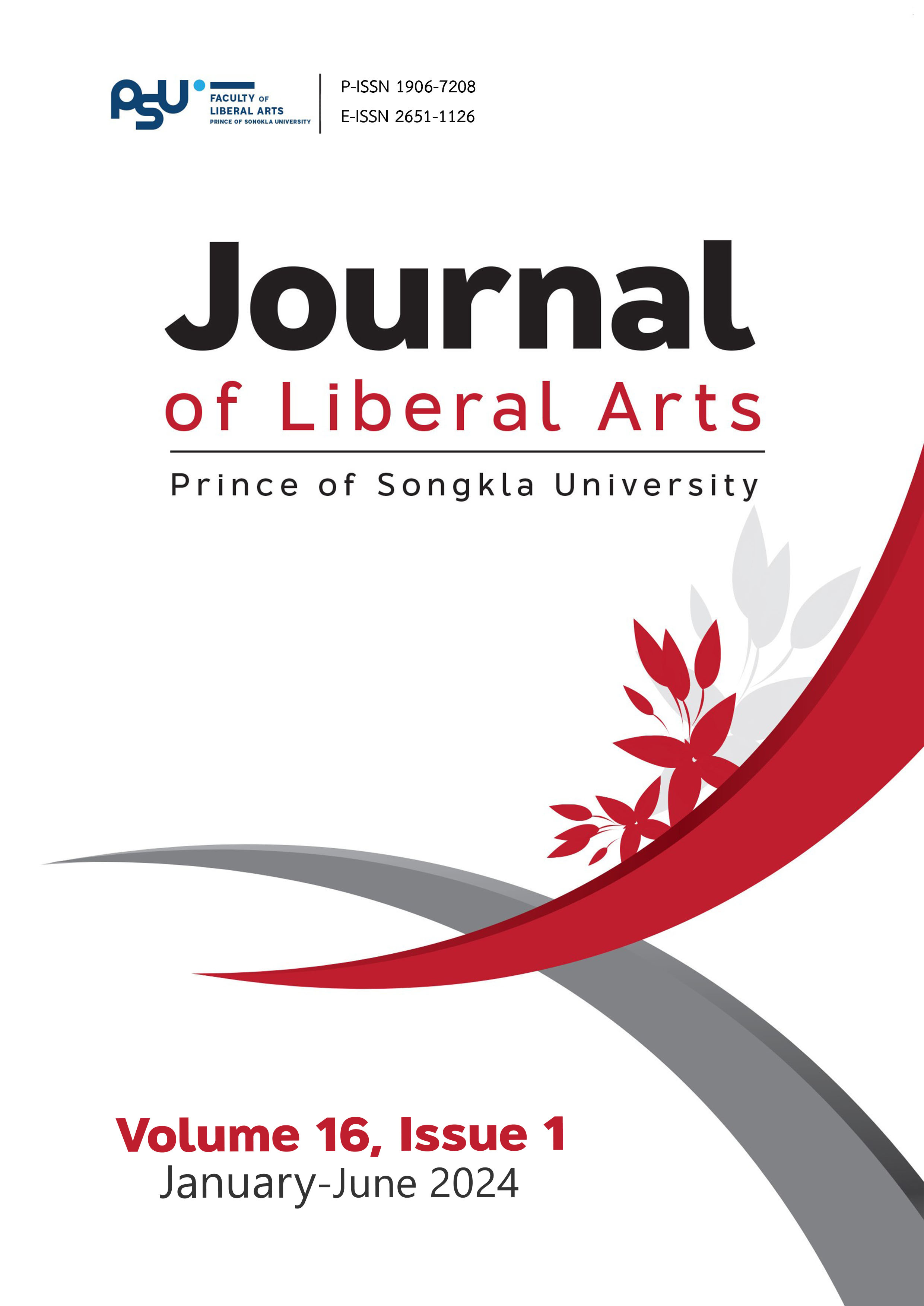การศึกษารูปแบบภาษาและการชนะใจคนด้วยอารมณ์ขันของรายการ Rock & Roast
DOI:
https://doi.org/10.14456/jlapsu.2024.8คำสำคัญ:
รายการ Rock & Roast , รูปแบบการพูด , การชนะใจคนด้วยอารมณ์ขัน , รายการวาไรตี้จีนบทคัดย่อ
รายการตลกยืนเดี่ยว (Stand-up Comedy) ซึ่งมีต้นกำเนิดจากตะวันตกและปัจจุบันกำลังเฟื่องฟูในประเทศจีน กลายเป็นรายการวาไรตี้ที่คนทั่วไปเข้าถึงได้อย่างกว้างขวางผ่านรายการวาไรตี้ยอดนิยมอย่าง "ROCK & ROAST" การแสดงออกด้วยคำพูดตลกขบขันของนักแสดงตลกยืนเดี่ยวทำให้รูปแบบการแสดงนี้ได้รับความชื่นชอบจากคนทั้งประเทศ รายการตลกยืนเดี่ยวเป็นรูปแบบการแสดงที่มีเอกลักษณ์เฉพาะตัว มีรูปแบบคำพูดชัดเจน และเนื่องจากเป็นรายการที่พูดสดจำเป็นต้องดึงดูดผู้ชมอย่างรวดเร็ว นักแสดงจึงต้องมีความชำนาญในการใช้ภาษาที่เข้าใจง่ายและสามารถสร้างจุดเชื่อมโยงกับผู้ชมได้เป็นอย่างดี คำพูดในรายการตลกยืนเดี่ยวจะกระชับ เข้าใจง่าย และเต็มไปด้วยอารมณ์ขันมากกว่าเมื่อเปรียบเทียบกับภาษาเขียนที่เป็นทางการ การวิจัยครั้งนี้ใช้การวิเคราะห์วาทกรรมและเนื้อหาจากรายการที่ถอดเสียงออกมา โดยทำการตรวจสอบข้อความในรายการตลกยืนเดี่ยวอย่างเป็นระบบ
จากการศึกษาพบว่า การใช้อนุภาคกิริยาหรือคำพูดเสริมน้ำเสียง คำศัพท์ทางอินเทอร์เน็ต และคำศัพท์ภาษาถิ่นในรูปแบบคำพูด ทำให้ภาษามีชีวิตชีวามากขึ้น และคำหลายคำมีความแจ่มชัดและน่าสนใจ ซึ่งสามารถกระตุ้นให้เกิดอารมณ์ขันได้ง่าย เนื่องจากประเทศจีนมีภาษาถิ่นมากกว่าร้อยภาษา และในแต่ละภาษาจะมีคำศัพท์และการออกเสียงที่แตกต่างกันมาก การใช้ภาษาถิ่นช่วยให้นักแสดงใกล้ชิดกับผู้ชมมากขึ้น และทำให้นักแสดงมีตัวช่วยในการพูดที่หลากหลายซึ่งเมื่อผนวกกับอารมณ์ขันจะ ทำให้เกิดจุดที่สร้างเสียงหัวเราะได้อย่างมีเอกลักษณ์เฉพาะตัว อีกทั้งการใช้ภาษาถิ่นในบางสถานการณ์ไม่เพียงแสดงให้เห็นถึงจุดเด่นของแต่ละภูมิภาคเท่านั้น แต่ยังสร้างบรรยากาศที่ตลกขบขันที่ไม่เหมือนใครอีกด้วย
เอกสารอ้างอิง
Hu, G. W. (2022). A study of talk show language under the cognitive model theory [Master’s thesis, Sichuan Normal University]. China National Knowledge Infrastructure. https://kns.cnki.net/KCMS/detail/detail.aspx?dbname=CMFD202301&filename=1022034546.nh
Huang, B., & Liao, X. (2017). Modern Chinese. Volume 1 (Revised 6th ed.). (in Chinese). Higher Education Press.
National People’s Congress. (2018, March 11). Constitution of the People’s Republic of China (2018 Amendment). Xinhua News. Retrieved May 31, 2024, from http://www.xinhuanet.com/politics/2018lh/2018-03/22/c_1122572202.htm
“ROCK & ROAST” Season 3, Episode 7. (2020, September 2). Retrieved June 19, 2024, from Tencent Video https://v.qq.com/x/cover/mzc00200lhn9f21/m00340axepw.html
Sheng, L. Ch., & Han, M. (2006). The relationship between northeastern dialects and regional culture. Journal of Changchun Normal University, 11, 74-77.
Sina.com. (2022, January 11). “Lone Brave” makes “cicada larvae” popular. Sina. Retrieved October 31, 2023, from http://k.sina.com.cn/article_1988518703_7686632f001011jdt.html
Sun, X. (2018). A brief analysis of language in talk shows—Taking Season 3 of “ROCK & ROAST” as an example. Chinese Character Culture, 7, 18-20. doi:10.14014/j.:CNKI.cn11-2597/g2.2021.07.009
The Self-Cultivation of Proper Public Relations. (2022, November 21). Stand-up comedy on the ceiling: How long can the “comedic effect” last? Baidu. Retrieved July 2, 2023, from https://baijiahao.baidu.com/s?id=1750113164489040755&wfr=spider&for=p.c.
Wang, C. (2022). A study of Humorous Language in stand-up comedy [Master’s thesis, Central China Normal University]. China National Knowledge Infrastructure. https://kns.cnki.net/KCMS/detail/detail.aspx?dbname=CMFD202301&filename=1022091302.nh
Wang, J. X. (2023). A cognitive analysis of verbal humor in “ROCK & ROAST” from the perspective of comprehension theory. Western Radio and Television, 5, 92-94. doi:CNKI:SUN:XBGS.0.2023-05-031
Wang, J. Y. (2022). The language art of talk shows and audience alignment-Taking Season 4 of “ROCK & ROAST” as an example. Media Forum, 22, 57-60. doi:CNKI:SUN:CMLT.0.2022-22-017
Wang, X. J., & Liu, H. (2022). An analysis of rhetorical strategies in Humorous Language in “ROCK & ROAST”. Cai Xie Bian, 12, 155-157. doi:CNKI:SUN:CXBI.0.2022-12-053
Wang, Zh. G., & Liu, B. (2014). Investigation on the reception of dialect programs. Youth Journalist, (34), 23-24.
Xie, J., & Cui, M. W. (2023). A study on rhetorical devices in Humorous Language of talk shows from the perspective of relevance theory—Taking Season 4 of “ROCK & ROAST” as an example. Journal of Chuzhou University, 4, 43-49. doi:CNKI:SUN:CZSB.0.2023-04-009
Xue, Ch. R. (2005). An analysis of the artistic charm of northeast dialect sketches. Heilongjiang Historical Records, (11), 30-31.
Yang, J. (2021). A pragmatic study of talk show language: A case study of “Talk Show Conference” [Master’s thesis, Beihua Normal University]. https://kns.cnki.net/KCMS/detail/detail.aspx?dbname=CMFD202201&filename=1021750024.nh
Yang, L. (2019, August 4). Episode 3 of Season 2 of “ROCK & ROAST.” Retrieved June 19, 2024, from Tencent Video https://v.qq.com/x/cover/mzc00200iqko65a/f0041payivr.html
Yang, L. F. (2022). A multimodal discourse study of “ROCK & ROAST” [Master’s thesis, Harbin Normal University]. China National Knowledge Infrastructure. https://kns.cnki.net/KCMS/detail/detail.aspx?dbname=CMFD202202&filename=1022491134.nh
You, R. J. (2004). Hàn yǔ fāng yán xué dǎo lùn (A course in Chinese dialectology). (in Chinese), Shanghai Education Press.
Zhao, Q. Q. (2020). An analysis of verbal humor in “ROCK & ROAST” from the perspective of presupposition. Cultural Innovation Comparative Research, 11, 48-49. doi:CNKI:SUN:WCBJ.0.2020-11-020
Zheng, Z. S. F. (2012). Formation of Chinese dialect characteristics and analysis of historical levels. Journal of Linguistic Studies, (00), 1-5.
Zhou, F. Y. (2007). Dialects, errenzhuan, and the issue of northeastern regional culture. Folklore Research, (02), 140-150.
ดาวน์โหลด
เผยแพร่แล้ว
รูปแบบการอ้างอิง
ฉบับ
ประเภทบทความ
สัญญาอนุญาต
ลิขสิทธิ์ (c) 2024 Yujiao Ma, Assoc. Prof. Dr. Chatuwit Keawsuwan , Assoc. Prof. Dr. Kanokporn Numthong

อนุญาตภายใต้เงื่อนไข Creative Commons Attribution-NonCommercial-NoDerivatives 4.0 International License.
ลิขสิทธิ์บทความเป็นของผู้เขียน แต่วารสารศิลปศาสตร์ มหาวิทยาลัยสงขลานครินทร์ ขอสงวนสิทธิ์ในการเป็นผู้ตีพิมพ์เผยแพร่เป็นครั้งแรก






